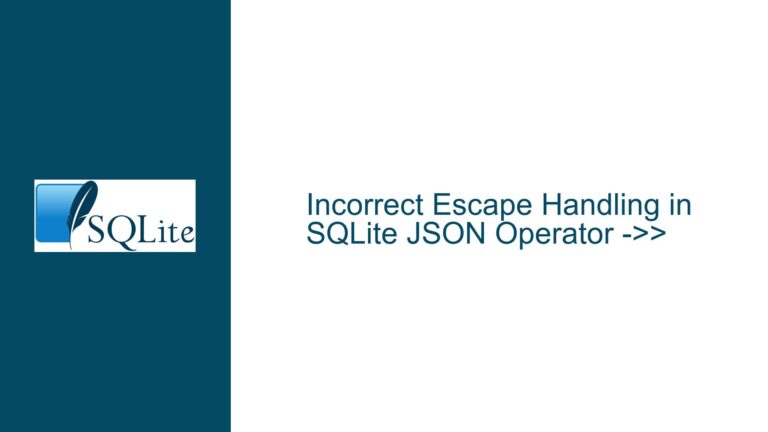SQLite’s Handling of Placeholders in ORDER BY Clauses
The Role of Placeholders in ORDER BY Expressions and Their Practical Implications
SQLite, as a lightweight and versatile database engine, is designed to be flexible in its syntax and usage. One of the areas where this flexibility becomes apparent is in the handling of placeholders within ORDER BY clauses. The ability to use placeholders in such contexts raises questions about their utility, the design philosophy behind their inclusion, and the potential pitfalls they may introduce. This post delves into the intricacies of using placeholders in ORDER BY expressions, exploring why SQLite allows them, the implications of their use, and how developers can navigate these nuances effectively.
The Design Philosophy Behind Allowing Placeholders in ORDER BY Clauses
SQLite’s syntax is designed to be permissive, adhering to the principle of "be liberal in what you accept." This philosophy is evident in its handling of placeholders within ORDER BY clauses. When a placeholder is used in an ORDER BY expression, SQLite treats it as a valid expression, even if it doesn’t result in meaningful sorting. For example, consider the query:
SELECT 42 ORDER BY ?1;
In this case, no matter what value is bound to the placeholder ?1, the result set will always remain unsorted. This behavior might seem counterintuitive, but it aligns with SQLite’s broader design goals. The database engine prioritizes flexibility and simplicity over enforcing strict syntactic constraints. Disallowing such constructs would require additional code and processing time, which contradicts SQLite’s lightweight nature.
The permissiveness of SQLite’s syntax also extends to its handling of integer literals in ORDER BY clauses. In SQL, an integer in an ORDER BY clause typically refers to the position of a column in the result set. However, when a placeholder is used, SQLite treats it as a literal value rather than a column index. This distinction is crucial because it prevents the placeholder from being interpreted as a column reference, which could lead to unexpected behavior.
The decision to allow placeholders in ORDER BY clauses is not an oversight but a deliberate design choice. It reflects SQLite’s commitment to providing a flexible and user-friendly interface, even if it means accepting constructs that may not always be useful. This approach allows developers to write more dynamic queries without being constrained by overly rigid syntax rules.
The Limitations and Potential Misuse of Placeholders in ORDER BY Clauses
While SQLite’s permissiveness in allowing placeholders in ORDER BY clauses offers flexibility, it also introduces potential pitfalls. One of the primary limitations is that placeholders in ORDER BY expressions do not provide any meaningful sorting functionality. As demonstrated in the earlier example, binding different values to the placeholder does not alter the order of the result set. This behavior can be confusing for developers who expect the placeholder to influence the sorting order.
Another limitation arises from the interaction between placeholders and column references. In SQL, integers in ORDER BY clauses are typically interpreted as column indices. However, when a placeholder is used, SQLite treats it as a literal value rather than a column reference. This means that even if the placeholder is bound to an integer, it will not be interpreted as a column index. For example, consider the following query:
SELECT name, age FROM users ORDER BY ?1;
If the placeholder ?1 is bound to the value 2, one might expect the result set to be sorted by the second column (age). However, SQLite will treat the placeholder as a literal value, resulting in no meaningful sorting. This behavior can lead to confusion, especially for developers who are accustomed to using integers as column references in ORDER BY clauses.
The potential misuse of placeholders in ORDER BY clauses is further compounded by the fact that SQLite does not provide any warnings or errors when such constructs are used. This lack of feedback can make it difficult for developers to identify and correct issues in their queries. In more sophisticated database systems, such constructs might trigger warnings or even errors, helping developers avoid unintended behavior. However, SQLite’s lightweight nature means that it does not include such safeguards, placing the onus on developers to ensure that their queries are correctly formulated.
Best Practices for Handling Placeholders in ORDER BY Clauses
Given the limitations and potential pitfalls associated with using placeholders in ORDER BY clauses, developers should adopt best practices to avoid unintended behavior. One approach is to avoid using placeholders in ORDER BY expressions altogether. Instead, developers can construct their queries dynamically, ensuring that the ORDER BY clause contains valid column references or expressions. For example, instead of using a placeholder, a developer could write:
SELECT name, age FROM users ORDER BY age;
This approach eliminates the ambiguity introduced by placeholders and ensures that the query produces the desired results. However, in cases where dynamic sorting is required, developers can use conditional logic to construct the ORDER BY clause based on the desired sorting criteria. For example, in a programming language like Python, a developer might write:
sort_column = "age" # This could be dynamically determined
query = f"SELECT name, age FROM users ORDER BY {sort_column};"
By constructing the query dynamically, developers can achieve the desired sorting behavior without relying on placeholders in the ORDER BY clause. This approach also makes the query more transparent and easier to debug, as the sorting criteria are explicitly defined.
Another best practice is to validate the values bound to placeholders before executing the query. This is particularly important when the placeholder is intended to represent a column index. By validating the value, developers can ensure that it falls within the valid range of column indices and avoid potential errors. For example, in a C++ application using an ORM library, a developer might write:
int sort_column = 2; // This could be dynamically determined
if (sort_column >= 1 && sort_column <= 2) {
auto query = select(&User::name, &User::age, from<User>(), order_by(sort_column));
// Execute the query
} else {
// Handle invalid sort column
}
By validating the sort_column value, the developer ensures that it corresponds to a valid column index, preventing potential issues when the query is executed.
In conclusion, while SQLite’s handling of placeholders in ORDER BY clauses offers flexibility, it also introduces potential pitfalls that developers must navigate carefully. By understanding the limitations of placeholders and adopting best practices, developers can write more robust and reliable queries. Avoiding placeholders in ORDER BY expressions, constructing queries dynamically, and validating placeholder values are all strategies that can help mitigate the risks associated with this feature. Ultimately, the key to effective use of SQLite lies in understanding its design philosophy and leveraging its flexibility while being mindful of its limitations.






